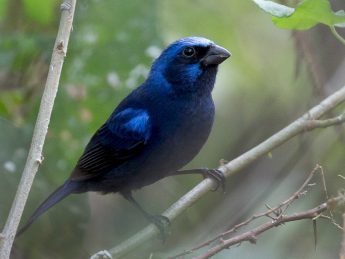Introduction
Quick Navigation
Cardinal birds are a group of birds that are known to occur in a number of places throughout the world. They are particularly resident in North America, South America, and the United Kingdom. In the general grouping of animals, cardinal birds belong to the phylum Chordata, order Passeriformes, superfamily Emberizoida, family Cardinalidae, and class Aves. In North America, particularly in the United States, cardinal birds have been designated as official birds in some states and are regarded to the extent that special legislation and acts have been formulated toward controlling interference of citizens with them. Depending on the continent, cardinal birds are otherwise known as cardinal-grosbeaks or cardinal-buntings. Cardinal birds are named, identified, and classified primarily by color such as black-headed grosbeak, blue grosbeak, indigo cardinal, blue bunting, and varied bunting.
See also reference
Locational Occurrence and Uniqueness of Cardinal Birds
Cardinal birds are known as natives of North America, South America, and lately, the United Kingdom. However, this does not mean that they do not occur elsewhere. Unlike most birds, cardinals are non-migratory. In the United States, cardinal birds occur in seven states which include Ohio, North Carolina, Virginia, Indiana, Illinois, Kentuchy, and West Virginia. In Canada, cardinals occur in Southeastern provinces such southwestern Nova Scotia, southeastern New Brunswick, Newfoundland, eastern Maine and Central New Hampshire. In South America, they are found in countries which include Mexico, Guatemala, and Belize. They are also found in the United Kingdom such as Ireland and British robins. Their dwellings in these places include woodlands, mountain forests, understories, gardens, wetlands, and backyards.
Apart from the general features of birds, cardinal birds are particularly distinct from other kinds of birds in color. This distinction with respect to color depends on the gender of the bird. Male cardinals are known to be characteristically red in color while female cardinals usually have pale brown color. Female cardinal birds may also have color blends between these extremes. There is the myth that the red color of male cardinals resulted from its feeds. Both male and female cardinal birds have black face.
Life Span and Feeding of Cardinal Birds
There is no definite longevity for cardinal birds because they occur in most cases as wild birds. However, it has been estimated that cardinal birds can live for three years on the average. It has been found that individual, undomesticated cardinals can live much longer – between thirteen and fifteen years – if not killed by hunting or poaching. On the contrary, records have quoted slightly more than twenty-eight years as the life span of captive, domesticated cardinal bird that ever lived.
During their lifetime, cardinal birds feed predominantly on grains of varying sizes such as berries, cracked corns, crushed peanuts which constitute small grains to larger grains which include black oil sunflower seeds, white milo, and safflower seeds; these constitute the best feeds particularly for the northern cardinals. They also like feeding on fruits such as grapes, apples, and watermelon in the summer. Cardinal birds are also great omnivores.
Symbolism and Spiritual Meanings of Cardinal Birds
Cardinal birds in general, represent many spiritual things. Whether a cardinal is sighted, flies in someone’s way or otherwise, its appearance is far from being ordinary. Perhaps, this is why many people who are spiritually sensitive often regard seeing a cardinal as representing a message from the Spirit, and so pay particular attention to the bird when it is encountered. People generally regard cardinal birds as a symbol of many things – the particular meaning depends on the behavior of the bird and what the individual is passing through at the time of the encounter – and usually, the individual who encounters a cardinal waits to observe or listen to decipher what message it wants to pass across. Cardinals pass across messages in different ways which include sounding, appearing in a dream, knocking, hitting, and gesturing. The symbolism and spiritual meanings of cardinal birds are enumerated as follows:
Cardinal birds, in the context of Christianity symbolizes hope, life, restoration, and eternity. This belief is particularly with respect to the male cardinals which are usually red-colored. The red color of the male cardinal is associated with the blood of Jesus Christ which was shed for the remission of the sins of mankind as a symbol of the love of God toward mankind through Christ. Therefore, sighting of red cardinals often reminds Christians about Christ’s love for mankind and the need for Christians to reciprocate the love to others. Perhaps, this is the most important symbolism or spiritual significance of cardinal birds for Christians.
It is believed that chirping of cardinal birds represents good luck or cheerfulness. Chirping means making a high short sound by a cardinal and in spiritual parlance, it is associated with the happy or lively mood of the bird. So when a cardinal bird chirps to someone, it is believed that they will be favored by people. When this happens in the dawn of the day, for instance, it is usually associated with a happy, prosperous day; that the day will be full of glamour and happiness.
It is believed that when someone sees a cardinal in a robe in a dream, it spiritually symbolizes bad luck. This usually means that unpleasant occurrence is imminent. In North America, it is regarded as a nightmare.
When a cardinal bird knocks someone’s window, it symbolizes impending good news in spiritual context. The individual feels excited and cheerfully look forward to the good news. On the contrary, when a male cardinal bird hits someone’s window, it is a sign of impending death.
Conclusion
Birds are a prominent component of the natural environment. This article is a review of cardinal birds, their symbolism, and spiritual meanings. It expounds the unique features of these birds, their various symbols, nativity, and their spiritual implications on the wellbeing and everyday life of people. It is hoped that the article will enhance an understanding and appreciation of these special creatures as a vital indicator of fortunes, misfortunes, and circumstances toward preserving them for posterity.

